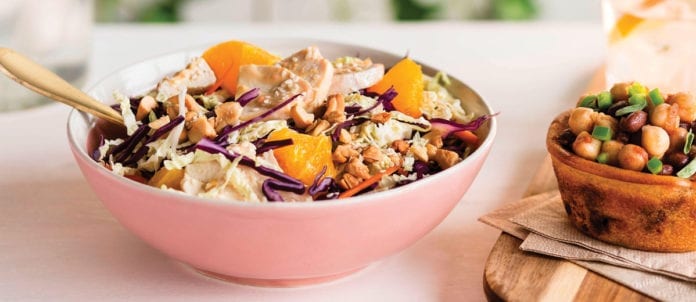“I was sitting at a major intersection in Barrie, Ont.,” says DavidsTea founder, David Segal. “Just observing what was around me, I saw a McDonald’s, a Burger King, a Tim Hortons and an Arby’s and I thought to myself — Mad Radish belongs on this corner as much of any of these restaurants.” Segal wondered why, in his own words, “the burger joint” was so ubiquitous and yet healthy, vegetable-centric fast food was only available in urban centres such as Toronto or Vancouver. Enter Segal’s Mad-Radish concept.
The phenomenal success story of DavidsTea allowed Segal to invest in Mad Radish. In 2008, DavidsTea was launched by a then-36-year-old beginner. Now, Segal’s starter company has become a $200-million, publicly traded retail chain. But Mad Radish is healthy foodservice, done differently. “Our general motto is ‘eating healthy food shouldn’t taste like taking your medicine’,” says Segal. “I mean, how are we born with this innate idea that we should trade flavour for health benefits?”
After studying the market and tasting the competition, Segal and former Marketing vice-president of DavidsTea, Stephanie Howarth, sensed they could generate a more effective, speedy and delicious operation. Brainstorming sessions began in 2016 and the two bantered back and forth for a year trying to figure out a game-plan for upping the salad and hot-bowl business. During the time between conception and execution, they conducted “research,” dining at every salad or vegetable-based restaurant they could find to assess what was missing. “You might say it’s a crowded market but, when you actually look at what’s out there, these are concepts that simply haven’t evolved,” says Segal. “And you’ll notice consumers still wait quite a bit of time for their orders to be prepared.”
For menu creation, Segal brought in ex-Chase Hospitality Group chef Nigel Finley and vegan chef Briana Kim to craft made-from-scratch, haute cuisine that could be delivered in a timely manner — dishes such as soups, stews, warm bowls and salads. Warm bowls, such as the popular “Fired Up Chicken” ($13.95), Harissa Chickpea Stew ($10.95) and Butter Cauliflower Curry ($11.95) are priced above the $10 mark, whereas the hearty salads tend to be more than $12. Soups and stews have a lower price point at just $6 and hand-pies, such as Schwarma Chicken and Spicy Chickpea, sell for $3.75. A sweet Apple-Cinnamon hand pie (also $3.75) is a customer favourite.
With a menu that’s more than 50-per-cent vegan, Mad Radish appeals to foodies by sourcing local, organic and sustainable animal products when the recipe calls for it: organic chicken comes from Voltigeurs Farm in Quebec and sustainable salmon from Nova Scotia. Beef and pork are not on the menu, however, Mad Radish’s Smoky Caesar ($12.50) uses smoked mushrooms, garlic-marinated chickpeas and a cashew-based “parmesan” to add enough meatiness that the bacon bits and parmesan are not even missed.
Another advantage of the Mad-Radish concept is its seasonal, dynamic menu. “In the cold Canadian winters, you’ll find more hot bowls and warm options,” explains Segal. “Whereas in the summer, we’ll feature less of that and more salads and cold-food options.” This includes locally sourced ingredients that take dishes to the “next level.” Segal revealed a sneak peek of his spring menu, which includes chive flowers and nasturtium petals sprinkled onto salads. “But with such fine attention to detail, customers shouldn’t confuse us with rabbit food,” laughs Segal. “Our bowls are hearty and we want you to leave feeling full.” And it’s all homemade — from the baked-daily focaccia to the never-frozen corn (shaved off the cob).
In terms of drink choices, there are meals-in-themselves smoothies (pumpkin pie, espresso or Nutty by Nature sell for $6.75 each) or cans of the trendy LaCroix — a flavoured sparkling-water beverage that’s surged in sales thanks to consumers’ shift away from traditional soft drinks. Tea is conspicuously missing from the menu.
If this operation sounds perfectly tailored towards the millennial consumer — it no doubt is. But that wasn’t Segal’s point of entry into the marketplace. “Of course, every business wants that millennial customer,” says Segal. “But, to be honest, the plan wasn’t to deliver a specifically millennial business. Our big picture was to create a truly superior product for people of any age.”
That said, its millennial customers appreciate how well-conceived the Mad Radish mobile app is — especially since it was created alongside the business plan, rather than as an afterthought. With the app, guests can easily pre-order meals for pickup and a portion of each online order goes towards a donation of produce to Community Food Centres Canada. “Customers can also track the progress of their social contribution online,” says Segal.
Given the clean aesthetic of DavidsTea, it comes as no surprise that Mad Radish’s interiors remain minimal, sparse and with hints of wood that allude to the naturalness of the ingredients. Segal sought the expertise of Hencho, a Brooklyn-based design firm, to streamline its concepts into a resonant dining experience, logo and app. Social conscientiousness is built right into the business model with a no-trash turnout (all take-out containers are 100-per-cent compostable).
With three Ottawa locations and one at Yonge and Eglinton in Toronto, Segal looks towards expansion, with three more locations planned to open this summer in Toronto and one more in 2020. From there, Segal says he wants to further expand with 10 additional units in Toronto. “I’d like to open in Montreal as well,” he notes. “It’s our head office for DavidsTea, so it makes sense.”
Written by Jennifer Febbraro


















